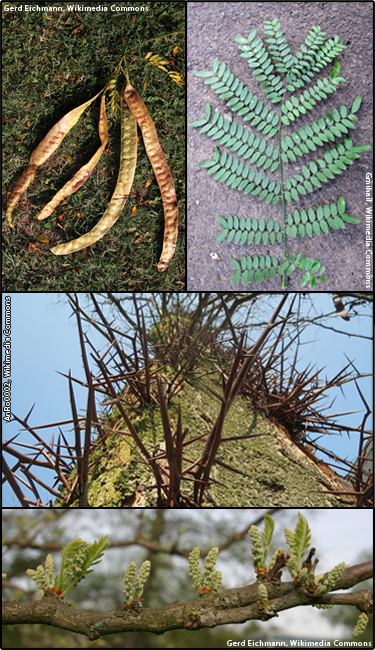Honeylocust (Gleditsia triacanthos)
 Synonyms: Gleditsia triacanthos var. inermis
Synonyms: Gleditsia triacanthos var. inermisDescription: Planted as an ornamental and windbreaks. In recent years, honeylocust has been tested as a biomass fuel.
Habit: Medium growing tree with a large, spreading crown and capable of reaching a height of 80 feet tall.
Leaves: Alternate, pinnately compound, 5-8 inches long, 15-30 leaflets with 4-7 pairs of minor leaflets. Leaflets are 0.50 -1.5 inches long, ovate to elliptic and green to yellow-green in color.
Stems: Gray-brown to bronze in color, smooth, horizontal lenticels, clusters of large, branched thorns.
Flowers: Small, greenish yellow in color, borne in 2-3 inch long narrow, drooping clusters; fragrant.
Fruit and seeds: 6-8 inches long, flattened, red-brown in color, leathery, pod; becomes dry and twisted. Seeds are oval, dark brown in color, shiny, 1/3 inch long.
Habitat: Native to parts of the United States but can be weedy and invasive in some areas. Can be found in upland woodlands, old fields, fencerows, floodplains and rocky hillsides.
Reproduction: By seed and vegetatively.
Similar species: Water locust (Gleditsia aquatica), Silktree (Albizia julibrissin, Black locust(Robinia pseudoacacia)
Monitoring and rapid response: Prescribed fire is not recommended as the plant will resprout. Credits: The information provided in this factsheet was gathered from the USDA Forest Service Fire Effects Information System and Virginia Tech Dendrology.
Individual species images that appear with a number in a black box are courtesy of the Bugwood.org network (http://www.invasive.org).Individual photo author credits may not be included due to the small display size of the images and subsequent difficulty of reading the provided text. All other images appear courtesy of Google (http://images.google.com).
